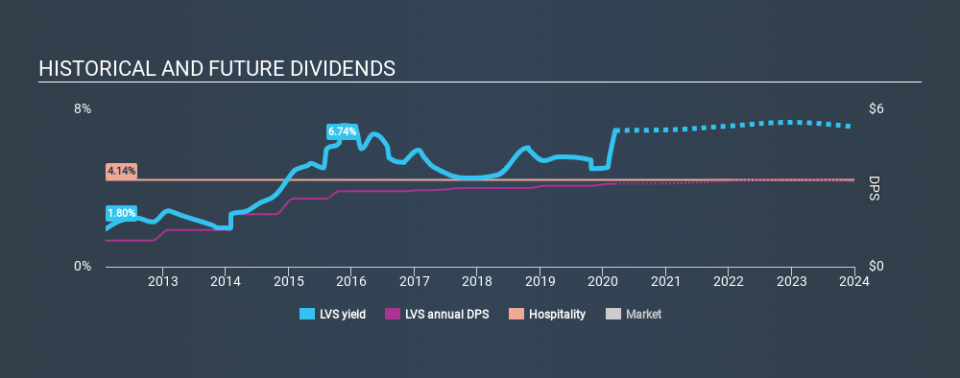We Wouldn't Be Too Quick To Buy Las Vegas Sands Corp. (NYSE:LVS) Before It Goes Ex-Dividend

Las Vegas Sands Corp. (NYSE:LVS) stock is about to trade ex-dividend in 4 days time. You will need to purchase shares before the 17th of March to receive the dividend, which will be paid on the 26th of March.
Las Vegas Sands's next dividend payment will be US$0.79 per share, on the back of last year when the company paid a total of US$3.16 to shareholders. Calculating the last year's worth of payments shows that Las Vegas Sands has a trailing yield of 6.5% on the current share price of $48.63. Dividends are an important source of income to many shareholders, but the health of the business is crucial to maintaining those dividends. As a result, readers should always check whether Las Vegas Sands has been able to grow its dividends, or if the dividend might be cut.
View our latest analysis for Las Vegas Sands
Dividends are typically paid from company earnings. If a company pays more in dividends than it earned in profit, then the dividend could be unsustainable. Its dividend payout ratio is 88% of profit, which means the company is paying out a majority of its earnings. The relatively limited profit reinvestment could slow the rate of future earnings growth. It could become a concern if earnings started to decline. Yet cash flow is typically more important than profit for assessing dividend sustainability, so we should always check if the company generated enough cash to afford its dividend. Over the past year it paid out 134% of its free cash flow as dividends, which is uncomfortably high. We're curious about why the company paid out more cash than it generated last year, since this can be one of the early signs that a dividend may be unsustainable.
While Las Vegas Sands's dividends were covered by the company's reported profits, cash is somewhat more important, so it's not great to see that the company didn't generate enough cash to pay its dividend. Were this to happen repeatedly, this would be a risk to Las Vegas Sands's ability to maintain its dividend.
Click here to see the company's payout ratio, plus analyst estimates of its future dividends.
Have Earnings And Dividends Been Growing?
Companies that aren't growing their earnings can still be valuable, but it is even more important to assess the sustainability of the dividend if it looks like the company will struggle to grow. If earnings fall far enough, the company could be forced to cut its dividend. With that in mind, we're not enthused to see that Las Vegas Sands's earnings per share have remained effectively flat over the past five years. It's better than seeing them drop, certainly, but over the long term, all of the best dividend stocks are able to meaningfully grow their earnings per share.
Another key way to measure a company's dividend prospects is by measuring its historical rate of dividend growth. Las Vegas Sands has delivered an average of 15% per year annual increase in its dividend, based on the past eight years of dividend payments.
Final Takeaway
Should investors buy Las Vegas Sands for the upcoming dividend? Earnings per share have not grown and Las Vegas Sands's profit payout ratio looks reasonable. However, it paid out a disconcertingly high percentage of its cashflow, which is a worry. It's not an attractive combination from a dividend perspective, and we're inclined to pass on this one for the time being.
Having said that, if you're looking at this stock without much concern for the dividend, you should still be familiar of the risks involved with Las Vegas Sands. For example, we've found 4 warning signs for Las Vegas Sands (1 is significant!) that deserve your attention before investing in the shares.
A common investment mistake is buying the first interesting stock you see. Here you can find a list of promising dividend stocks with a greater than 2% yield and an upcoming dividend.
If you spot an error that warrants correction, please contact the editor at editorial-team@simplywallst.com. This article by Simply Wall St is general in nature. It does not constitute a recommendation to buy or sell any stock, and does not take account of your objectives, or your financial situation. Simply Wall St has no position in the stocks mentioned.
We aim to bring you long-term focused research analysis driven by fundamental data. Note that our analysis may not factor in the latest price-sensitive company announcements or qualitative material. Thank you for reading.

